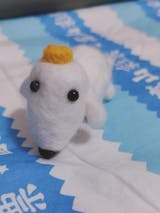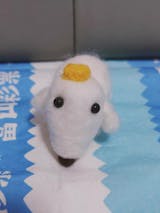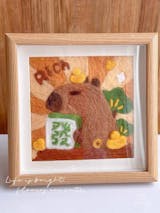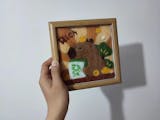
What is Wool Felt?
Share
From Fiber to Friend: The Ultimate Guide to Wool, Felting & Joypok's Healing Craft
You’ve seen the magic on social media: tiny, lifelike figures born from soft fluff—a charming penguin, a cozy coaster, or a display-ready pet portrait. This is needle felting, and it's experiencing a renaissance in our fast-paced world. Needle felting (often called “wool felting” or just “felting”) is a craft where you poke loose wool with a barbed needle so the fibers tangle and lock together. With time and gentle repetition, the fluffy fibers turn into a firm, stable shape.
At Joypok, we believe felting is more than just a hobby—it's an essential form of tactile meditation and a unique way to "Poke Your Joy" into existence. We offer a moment of calm and connection in a world of digital noise.
Why Wool Works & The Science of Felting
Wool is the ultimate creative medium, and its suitability for felting comes down to its unique structure:
1. The Secret Weapon: Wool Scales
Every strand of wool fiber is covered in microscopic, overlapping scales. This scale structure causes the fiber to exhibit a higher friction when moving tip-first than in reverse.
- How Needle Felting Works: When you repeatedly stab the wool with a barbed needle, the barbs catch these scales, forcing the fibers to intertwine and tangle. This agitation, combined with the scales locking together, creates a dense, cohesive fabric—felt.
- A Key Factor: This scaly structure, along with the natural waviness (crimp) of the fiber, is what gives wool its unique felting power. Most synthetic fibers lack these scales, which is why they do not felt on their own.
2. The Two Main Methods
- Needle Felting (Dry Felting): This uses a barbed needle to tangle fibers without water. This clean, portable, and precise method is what all Joypok DIY kits are designed for.
- Wet Felting: This combines wool + warm water + soap + friction. It's great for flat sheets or simple shapes, but less precise than needle felting for small characters.
The Basic Materials (and the Joypok Difference)
1. Needles: Your Precision Tool
Barbed felting needles come in different gauges (thickness) and profiles (shape):
| Gauge | Thickness | Primary Function |
| Lower Number (e.g., 36) | Thicker | Shaping & Fastening parts together quickly. |
| Higher Number (e.g., 40) | Finer | Refining and Smoothing the outer surface. |
Joypok Quality: All our kits contain the necessary professional-grade needles so you can focus on the relaxing process, not worrying about bent or broken tools.
2. Your Safe Work Surface
You need a safe place to poke:
- Felting Mat / Pad: A foam pad protects your table and needle tips.
- Frame-Board: Some Joypok kits [Internal Link: DIY Product Page] felt directly onto a board for a clean, display-ready finish.

How Needle Felting Works – The 4 Core Steps
This is the "poke-to-shape" method you’ll use for every project:
1. Make a Base: Roll or fold the wool (core fibers) into the rough shape (ball, cone, etc.).
2. Poke to Compress: Use a thicker shaping needle (e.g., 36/38). Poke straight in-and-out to avoid bending or breaking the needle. Rotate the piece as you go.
3. Add Forms & Attach Parts: Build ears, noses, etc. Overlap fibers where the joint is, then poke through both layers so they lock securely.
4. Smooth & Detail: Switch to a finer needle (38–40) and add thin layers of colored wool. Light, even pokes will give you that clean, professional surface.
Ready to Poke Your Joy?
Felting is your invitation to slow down and create something real and meaningful. Whether you're starting a new mindful hobby or seeking to immortalize a cherished memory, Joypok is here to guide your journey.
Start with a kit designed for first-timers—everything in one box so you can focus on the fun.
Your Next Step to Joyful Creation
👉 Explore DIY Needle Felting Kits & Begin Your Journey (Perfect for first-timers, stress relief, and quick, adorable projects.)







